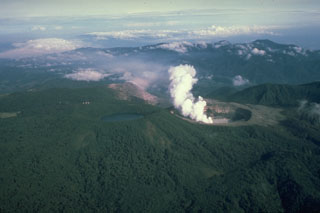Report on Poas (Costa Rica) — March 2000
Bulletin of the Global Volcanism Network, vol. 25, no. 3 (March 2000)
Managing Editor: Richard Wunderman.
Poas (Costa Rica) Conspicuous plumes and abundant low-frequency earthquakes in late 1999
Please cite this report as:
Global Volcanism Program, 2000. Report on Poas (Costa Rica) (Wunderman, R., ed.). Bulletin of the Global Volcanism Network, 25:3. Smithsonian Institution. https://doi.org/10.5479/si.GVP.BGVN200003-345040
Poas
Costa Rica
10.2°N, 84.233°W; summit elev. 2697 m
All times are local (unless otherwise noted)
Comparative quiet continued at Poás; however, in addition to the fumarolic degassing often seen, seismicity was relatively high during the reporting period, June 1999-January 2000, when low-frequency earthquakes typically registered over 4,000 times per month (table 9). For comparison, a relative high in 1999 occurred in May when low-frequency events occurred ~1,400 times, and during a high in January 1998, when there were over 2,500 events. On 18 July 1999 an MR 3.1 earthquake occurred with 6 km focal depth and an epicenter 5 km NW of the active crater.
Table 9. A summary of seismic, temperature, and lake height data for Poás during July 1999-January 2000. Lake heights are with respect to the previous month and positive upwards (rising lake levels). The stated temperature for the pyroclastic cone's degassing refers to the value at an accessible point where the measurements are taken regularly. The seismic station POA2 lies 2.8 km SW of the active crater. "NR" indicates information absent and not reported. Courtesy of OVSICORI-UNA.
| Month | Low-frequency earthquakes | Mid-frequency earthquakes | Total earthquakes | Crater lake temperature | Surface elevation change of crater lake |
| Jun 1999 | 2,571 | -- | -- | -- | -- |
| Jul 1999 | 2,996 | 64 | 3,061 | 32°C | -47 cm |
| Aug 1999 | 4,548 | 184 | 4,736 | 37°C | -32 cm |
| Sep 1999 | 5,264 | 274 | 5,542 | 40°C | -- |
| Oct 1999 | 4,743 | 190 | 4,987 | 38°C | -- |
| Nov 1999 | 4,142 | 221 | 4,393 | 33°C | 101 cm |
| Dec 1999 | 4,278 | 405 | 4,679 | 35°C | 156 cm |
| Jan 2000 | -- | -- | low | 40°C | ~140 cm |
Tremor, which was seldom reported in 1999, took place for less than about 0.5 hours a day during October-November 1999. In contrast, tremor averaged only 0.1 hours a day during December 1999. In contrast, tremor durations of 20 to 70 hours were common in early 1998. Also appearing in the month of October 1999 were 5 unusual low-frequency events in conjunction with tremor; these low-frequency earthquakes had periods of 40-175 seconds.
During August -October, the pyroclastic cone's degassing led to unusually high plumes reaching 0.7 to 2 km above the crater floor. December plume heights ranged between 0.7 and 1 km. Some of the hottest temperatures were measured near the pyroclastic cone: up to 95°C during December-January and often over 92°C when reported during other months in late 1999.
Geological Summary. The broad vegetated edifice of Poás, one of the most active volcanoes of Costa Rica, contains three craters along a N-S line. The frequently visited multi-hued summit crater lakes of the basaltic-to-dacitic volcano are easily accessible by vehicle from the nearby capital city of San José. A N-S-trending fissure cutting the complex stratovolcano extends to the lower N flank, where it has produced the Congo stratovolcano and several lake-filled maars. The southernmost of the two summit crater lakes, Botos, last erupted about 7,500 years ago. The more prominent geothermally heated northern lake, Laguna Caliente, is one of the world's most acidic natural lakes, with a pH of near zero. It has been the site of frequent phreatic and phreatomagmatic eruptions since an eruption was reported in 1828. Eruptions often include geyser-like ejections of crater-lake water.
Information Contacts: E. Fernandez, E. Duarte, V. Barboza, R. Sáenz, E. Malavassi, R. Van der Laat, T. Marino, J. Barquero, and E. Hernández, Observatorio Vulcanologico y Sismologico de Costa Rica, Universidad Nacional (OVSICORI-UNA), Apartado 86-3000, Heredia, Costa Rica.

